I have reviewed the current Broadway revival of Company for the website Critics at Large. You can read that review at https://www.criticsatlarge.ca/2022/01/inhospitable-marianne-elliotts-revival.html.
Update
Although it’s theater-adjacent, rather than theater, I have reviewed the movie Cats for the website Critics at Large. You can read that review at https://www.criticsatlarge.ca/2019/12/kitty-litter-cats.html.
Update
I have reviewed the current Broadway production of Oklahoma! for the website Critics at Large. You can read that review at https://www.criticsatlarge.ca/2019/05/dust-bowl-oklahoma.html.
Paradise Lost: Berkeley Rep’s “Paradise Square”
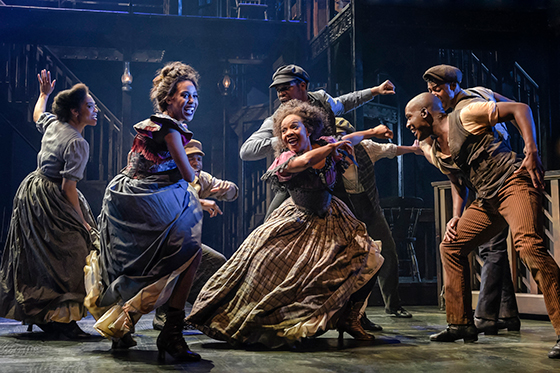
Sydney Dupont (far right) and members of the ensemble in Paradise Square. (Photo: Allesandra Mello)
Jerome Kern once said, “Irving Berlin is American music.” In an earlier era, the same could have been said of Stephen Foster, who wrote plaintive melodies and haunting lyrics that are still sung more than a hundred and fifty years later. Berkeley Rep’s new musical Paradise Square bills itself as based on the songs of Foster, and it features big names among its creators and production staff (though none bigger than Foster): Moisés Kaufman (the director and co-creator of The Laramie Project) directs, the legendary Bill T. Jones choreographs, and there are additional luminaries who worked on the material. The show was originally conceived by Larry Kirwan under the name Hard Times (after the Foster song); producer Garth Drabinsky bought the rights and brought in playwright Craig Lucas (Prelude to a Kiss and the book for The Light in the Piazza) for a rewrite, and then brought in another playwright, Marcus Gardley (black odyssey), for a final rewrite.
Having recently seen Conor MacPherson’s heartbreaking Girl from the North Country, wherein MacPherson wove existing songs by Bob Dylan into his Depression-era tale of loss and heartbreak (Kern’s approbation could easily apply to Dylan for the second half of the twentieth century), I was hopeful that Paradise Square might be able to do the same service for Foster’s songs.
Paradise Square doesn’t actually use Foster’s tunes, it adapts them. You may hear a Foster lyric, but it’s set to different notes (sometimes vastly different). You may hear a Foster tune, but it most likely features completely rewritten words. (The music is credited to Kirwan and Jason Howland. Howland is the composer of the 2005 musical version of Little Women. The lyrics are credited to Nathan Tysen, who did similar duties for Amélie and Tuck Everlasting. They are all gracious enough to say their work is “based on” Foster’s.)
As Kirwan, Lucas, and Gardley have set it up, it’s 1862 and Paradise Square is a saloon in the Five Points neighborhood of Manhattan, a slum built on a cesspool, where anything goes as far as vice, but also where free blacks and Irish immigrants live in relative accord. A pair of mixed-race couples, Irish immigrant Annie (Madeline Trimble) and her African-American husband, the Reverend Samuel E. Cornish (Daren A. Herbert), Annie’s brother Willie (Brendan Wall) and his fiancée, Nelly (played by understudy Gabrielle McClinton the night I saw it), run the place, but when Willy is killed in the Battle of Fredericksburg, Nelly essentially manages the joint herself. Annie helps out, but she and the Reverend are also occupied aiding fugitive slaves as they proceed along the Underground Railroad. One such is William Henry Lane (Sidney Dupont), who has a price on his head and has been separated from his love, Angelina Baker (understudy Hailee Kaleem Wright). (Lane is an actual historic figure, a free-born black man, who combined early African-American dance moves with Irish step dancing and is celebrated as the originator of American tap-dancing. He died in 1852; the authors take many liberties to include him here.) Because this isn’t enough plot, Annie’s nephew Owen (A.J. Shively, recently seen in the touring production of Bright Star) arrives from Ireland, and none other than Stephen Foster himself (Jacob Fishel), broke and estranged from his family, becomes the house piano player. He does so under an assumed name, because of course, African-American Nelly has no use for the romantic plantation minstrelsy of Stephen Foster. She’s woke, dammit. Add a dance contest between Owen and William and the 1863 draft riots to all this, and things are just bound to heat up. Or not.

(Front, l to r) Sidney Dupont (William Henry Lane) and A.J. Shively (Owen Duignan); (Background, l to r) Jacob Fishel (Stephen Foster), Daren A. Herbert (Rev. Cornish), and Madeline Trumble (Annie). (Photo: Kevin Berne)
Despite all the research and all the talent (there are 32 cast members) involved in this huge production, there’s not a single believable instant on stage. Everybody shouts, everybody screams, everybody is really angry. This show’s been cranked up to eleven, but there’s nothing worth hearing, save for a stray Foster refrain here and there. Foster’s classic songs are shoehorned (and deformed along the way) into a big, noisy Broadway musical à la Les Miz, but with lots of unartful racial conflict and heaps of bad dialog. “You’re stuck between a rock and hard place,” William tells Owen. So’s the audience. “What makes a crowd become a mob?” a character asks to open the second act. Uh, a bad script? Foster’s classic “Jeannie with the Light Brown Hair,” written for his wife, transforms into “Janey with the Light Brown Hair,” and it’s actually sung by his spouse (Kennedy Caughell), who’s hunted him down to castigate him for not sending any money (she also blows his cover with Nelly), but now the song’s a big-belting Feminist anthem. My favorite Foster, the achingly sad “Why, No One to Love?” survives with its melody mostly intact, but is retitled “Someone to Love” with rewritten lyrics that lessen its beauty and dull its ache.
But it’s not just the lousy material that’s forced on Foster’s songs, it’s all the contemporary ideas about race and politics spoken by characters who would have no conception of our current problems and our ways of speaking about them. Gardley is careful to let us know that he isn’t gonna fall for any racist claptrap. One Irish character who decides he can’t stand the race-mixing one more minute, goes off saying, “People will follow me because I say they the things they’re thinking, but are afraid to say,” and you can almost hear the audience thinking “Ah, Trump.”
Nowhere is the ill fit of contemporary “wokeness” more evident than in Gardley’s (and Nelly’s) treatment of Foster. It’s clear he agrees with Nelly that Foster is a weak-willed, racist asshole. Nelly’s denunciation of Foster’s music—it romanticizes plantation life, it employs offensive dialect, much if it was written for blackface minstrel shows—is absolutely true, but it’s only a part of the truth. When a silly white woman tells Foster that she just loves “Old Black Joe” and “Swanee River,” we know she’s really saying, “I’m a racist!” Here’s Gardley from an interview included in the program: “What’s interesting about what we’re doing, in terms of appropriation, is that we’re taking Stephen Foster’s music and rearranging it so that it is more comfortable for the contemporary ear. [!] That way, we can talk about why it’s problematic. [!] If I were to be writing a musical and every song has a lyric that makes people uncomfortable because it’s racist, then I would be shut down.” Every Foster song has a racist lyric? “Jeanie with the Light Brown Hair”? “Beautiful Dreamer”? Paul Robeson thought highly enough of “Old Black Joe” to record it, although he did make a single change to the lyrics, changing “Old Black Joe” to “Poor Old Joe.” Mavis Staple’s rendition of “Hard Times” is devastating, wear and struggle inherent in every gorgeous note.
But Gardley is willing to make a concession: “There’s something about Stephen Foster’s melodies that does qualify, in my mind, him as a great artist.” Good to know, but why then botch his airs with “improvements”?
If only Kaufman and Gardley had paid as much notice to the artistry of their piece as they did to the politics. They’re so busy getting the correct messages across that they fail utterly to evince any humanity in their characters. Kaufman’s direction is a mess. The cast plays emotions instead of objectives, and people wander across the back and front of the stage at odd moments. The show’s main impression is one of assault, tinny ideas bellowed at maximum volume. Bill T. Jones’ choreography, incorporating Irish step dancing (several of the cast members are veterans of the Riverdance show) and the thigh-slapping, hand-clapping, and sinuous moves of early African-American dance, is often impressive (and the ensemble features some amazing dancers, Shively and Dupont chief among them), but the dance sequences aren’t well integrated. Energy flags before a number starts and deflates after it ends. And the effort the cast expends in dance starts to blend with the all too obvious work they’re doing when they yell their lines or bleat their songs. Fatigue all around is the result.
To spend more words bashing this show would be pointless revenge for the bashing it gave me, so let me end with a little grace, the final stanzas and chorus of Foster’s “Why, No One to Love?”
Dark is the soul that has nothing to dwell on!
How sad must its brightest hours prove!
Lonely the dull brooding spirit must be
That has no one to cherish and love…
Many a fair one that dwells on the earth
Who would greet you with kind words of cheer,
Many who would gladly join in your pleasures
Or share in your grief with a tear.
No one to love.
No one to love.
Why, no one to love?
Where have you roamed in this beautiful world,
That you’re sighing of no one to love?
Paradise Square continues through March 3, 2018 at Berkeley Repertory Theatre. For more information, go to https://www.berkeleyrep.org.
To hear Paul Robeson sing “Poor Old Joe (Old Black Joe),” click here.
To hear Mavis Staples sing “Hard Times,” click here.
To hear Judith Edelman sing “Why, No One to Love?” click here.
Low Current: David Henry Hwang’s “Soft Power” at the Curran

Chinese television executive Xue Xing (Conrad Ricamora) bids his daughter (Kendyl Ito) farewell before flying to America. (Photo by Craig Schwartz)
David Henry Hwang’s new musical (coyly called “a play with a musical”) Soft Power, featuring a score by Jeanine Tesori, is a political burlesque for the Trump era that ends with a earnest plea for democracy. It features a character named David Henry Hwang (played by Francis Jue), described as “the best Chinese-American playwright” there is. “I hear there’s not that many,” another character comments. This is Xiu Xing (Conrad Ricamora) a Chinese television executive who has hired Hwang to develop a television series set in Shanghai but meant for the worldwide market, especially the U.S. After some back and forth about eliminating anything from Hwang’s script that might make China look bad, no matter how innocuous to American ears and eyes, Hwang invites Xing and his mistress, a young American actress named Zoe (Alyse Alan Louis), to a fundraiser performance of The King and I that Hillary Clinton will be attending. While waiting in line to see Hillary, Xing excuses himself, and Zoe shares some tiresome ideas with Hwang about musicals as a potent “delivery system” for a nation’s culture even though the medium may be sentimental and the culture it shares highly questionable. Xing returns and relates how a well-connected friend slipped him to the front of the line where he and Hillary had a moment, claiming that she said to him, “We could learn a lot from China.” Cut to election night, where Xing cannot understand how Hillary could have lost due to the mysterious workings of the Electoral College. Hwang walks home alone, stunned like the rest of the nation, when he is stabbed in the neck by an unknown assailant.
As he blacks out, he has a dream. It’s 50 years in the future and China now leads the world in both hard (military and economic) power and soft (cultural) power. Chinese television is broadcasting a beloved classic of that quintessentially Chinese art form, the musical. (“Cultural appropriation” has erased the culture of its original perpetrators.) It turns out to be a skewed retelling of the story we’ve already seen; time has scrambled what actually happened, and Xing’s mistress this time around is Hillary Clinton, also played by Louis.
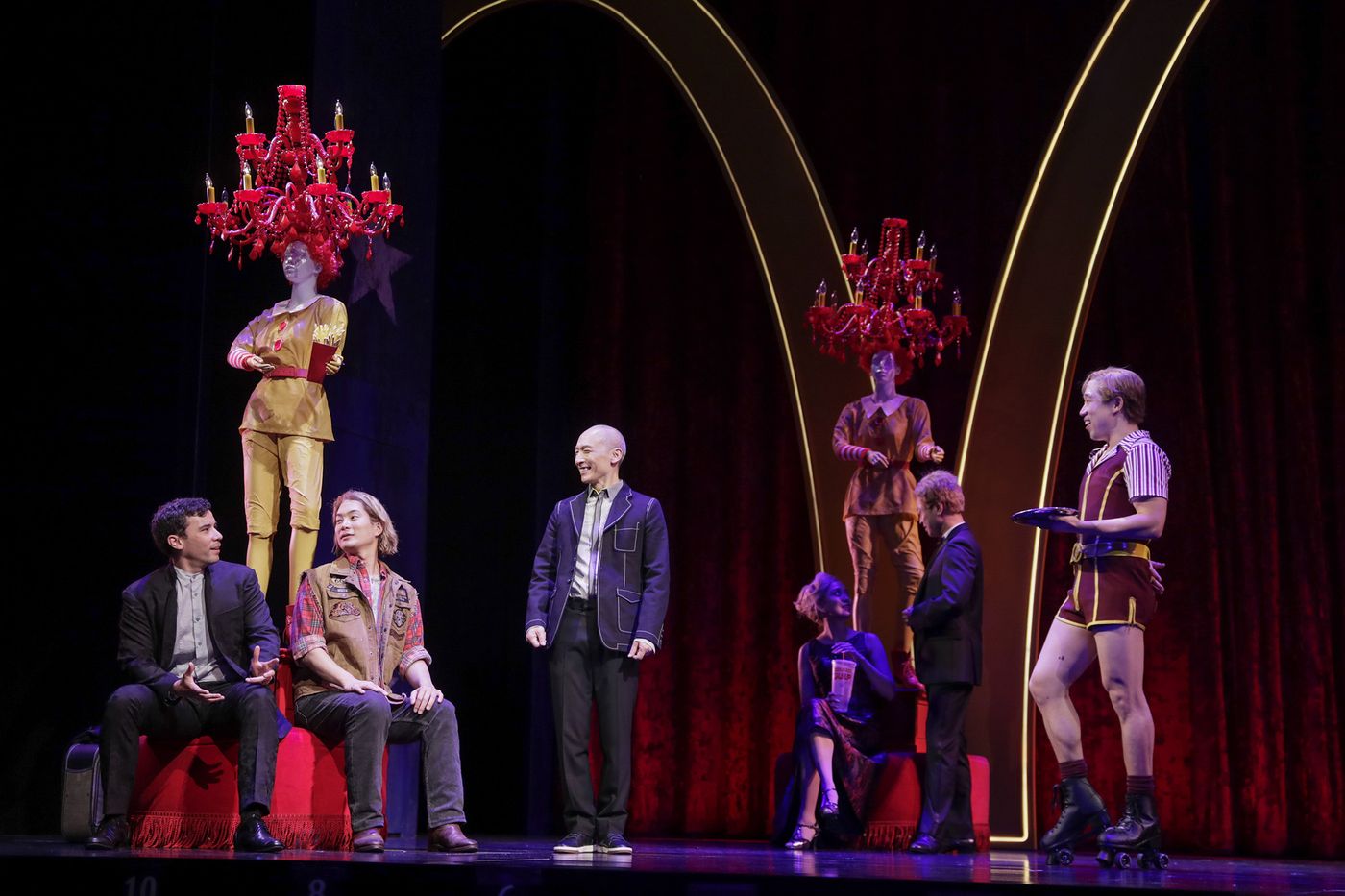
Xing (left) and David Henry Hwang (Francis Jue, center) attend a Hillary fund raiser. At McDonald’s. (Photo by Craig Schwartz.)
This musical-within-a-play is a comic nightmare version of America where guns, violence, and white (thus, inauthentic) hip-hop abound (the Asian American ensemble dons blond wigs to portray white people; Louis is the only white member of the cast). Hwang uses this conceit to illustrate how the two countries get each other wrong, but he’s also scoring obvious points about the sorry state of America in the Trump age (though Trump’s name is never mentioned in the show). A sample song title: “Good Guy with a Gun.” Some of the gags are funny, but nothing adds up to anything. It’s like an argument against America told in those misspelled and poorly sourced political memes that are so prevalent on Facebook.
In the program notes, director Leigh Silverman states, “[W]e wanted to make a show that was rich with emotion, but not with sentiment or melodrama.” She clearly means sentimentality, which is false or manipulated sentiment (“sentiment” is a synonym for emotion), but this inadvertently points out that the show’s creators repeatedly confuse sentimentality with sentiment. (And they’re not too clear on melodrama either: Hwang was the victim of a stabbing attack in real life but it didn’t happen on the night Clinton lost. The perpetrator and the motive were never discovered, but the play’s time-shift and musings from the Hwang character lead us to believe that it was anti-immigrant violence.)
The dream version of David Henry Hwang and Xing tell us that “face” (as in “saving face,” but with more of an emphasis on doing so through living up to one’s responsibilities) is important for the Chinese, while “heart” is what’s important for Americans, and this superficial bifurcation is treated as something revelatory as the dream Hwang sobs out in pain, blood oozing from his neck, that because of his dual heritage, he is subject to both heart and face. (Aren’t we all?)
What is supposed to convince us that America is worth saving is the eleven o’clock number where the dream Hillary belts about how important democracy is while also singing “It’s all a big show.” Well, which is it? (Musically, the song evokes “And I Am Telling You I’m Not Going,” and I wish I could believe Tesori is purposefully writing a pale—pun intended—imitation of that classic, but since Tesori’s work almost always sounds to me like pallid imitations of better songs, I’m doubtful.) At play’s end when the non-dream Hwang sings out in agony how great America’s ideals are, even if the country itself is a disaster, what we’re presented with is sentimentality, since there’s been no real evidence of those ideals, or even discussion, other than a mediocre, overly emotional song. (Jue, who’s been terrific in other performances I’ve seen, baldly overacts here, but I’m certain Silverman directed him to do so.)
Tesori utilizes a 23-piece orchestra for this production, but she has no idea what to do with it. None of her songs requires lushness on that scale, and Kai Harada’s sound design makes it so that the strings often sound synthesized. Conrad Ricamora is a highly charismatic performer, and Alyse Alan Louis is clearly talented, but her Zoe is a cliché of the pompous young artist sneering at everything that’s come before, and her Hillary is sketch comedy where the sketch goes on too long.
It’s a show with lots of words (which it confuses with ideas), but little logic, and the different levels—the play, the dream, the Chinese musical, the television broadcast of the musical—are used as distancing techniques—so distancing that ultimately, we can’t take anything seriously. (All these layers provide plausible deniability for Hwang, who gets to say, no, it’s not me saying this particular thing, it’s the Chinese, or it’s a dream, or… or….) And would a show considered a classic of Chinese culture end with a plea for democracy? Nothing is thought out in this piece, nothing resonates, nothing has any meaning. Soft Power ends with no message or theme or idea at all other than David Henry Hwang is pro-democracy. Good to know.
Despite the ending, most of the play is a poison pen letter to America, and, I would argue, to the American musical as well. The eye-rolling discussion about musicals between Zoe and Hwang avers that musicals are successful due to their sentimentality and campiness, even as they’re communicating dangerous “white savior,” culturally imperialistic myths, as in The King and I (which the program informs us is playwright Hwang’s favorite musical). All of the musical numbers in Soft Power are jokey, backed by choreographer Sam Pinkleton’s (Natasha, Pierre, and the Great Comet of 1812, Amélie) lampoons of Broadway dancing. For Hwang, musicals are something to be made fun of, not a vehicle for communicating fun, let alone serious emotion. Broadway singing and dancing can only achieve sentimentality, so he, as the creator of this particular piece, maintains an ironic remoteness from the work to combat the sap. (As an example of the ridiculousness of American musicals, a character points to Cats. Cats is a British musical, not American. A small point, but telling.) He doesn’t believe in the form, either as comedy or drama, and we can’t believe in his use of it. Soft Power has no power at all.

Democracy is good: The ensemble of Soft Power. (Photo by Craig Schwartz)
Soft Power plays at the Curran theatre in San Francisco through July 8. For more information go to https://sfcurran.com/shows/soft-power/.
A Supposedly Fun Thing I’ll Never Do Again: Transcendence Theatre’s “Stairway to Paradise”
 I’d heard rapturous things about Transcendence Theatre, a company that each summer, in Jack London State Park in the heart of Wine Country, mounts a musical revue utilizing young actors who have had some success on Broadway, national tours, or important regional productions, but aren’t yet big names. The venue, among the ruins of a 19th century winery and Jack London’s Beauty Ranch, where he spent the last years of his life, is spectacular. Picnicking is allowed beforehand, and local wineries offer selected varietals. The show begins just as the sun sets on the vineyards behind the stage, and swallows flit in the air above. Each ticket for the show adds on a $5 fee which goes directly to support the park. The management of the site is top notch; parking and other amenities are carefully thought out and executed by an army of staff and volunteers, despite the site’s remote location.
I’d heard rapturous things about Transcendence Theatre, a company that each summer, in Jack London State Park in the heart of Wine Country, mounts a musical revue utilizing young actors who have had some success on Broadway, national tours, or important regional productions, but aren’t yet big names. The venue, among the ruins of a 19th century winery and Jack London’s Beauty Ranch, where he spent the last years of his life, is spectacular. Picnicking is allowed beforehand, and local wineries offer selected varietals. The show begins just as the sun sets on the vineyards behind the stage, and swallows flit in the air above. Each ticket for the show adds on a $5 fee which goes directly to support the park. The management of the site is top notch; parking and other amenities are carefully thought out and executed by an army of staff and volunteers, despite the site’s remote location.
This year’s artistic presentation is hopefully named “Stairway to Paradise,” after the Gershwin song “I’ll Build a Stairway to Paradise.” The show starts with a “smooth jazz” version of Sondheim’s “Sunday” (from Sunday in the Park with George), followed by a mash-up of “Brand New Day” from The Wiz and “Beautiful City” from Godspell. Uh-oh. You hear instrumental snippets of the Gershwin tune, but no one ever sings it. And if you’re wondering what those first three numbers have to do with that title, you’ll be completely perplexed by what follows, Paul Simon’s “Me and Julio Down by the Schoolyard.” Indeed, all the song choices, driven by the show’s director and choreographer, Tony Gonzalez, seem as if they were picked out of a hat, contemporary pop and rock mixed up with (mostly) modern and (some) classic Broadway numbers. The program explains the rationale for six of them (why only six?) with blather about life’s journey, a topic generic enough that it could include any song ever written. (A woeful sample, discussing “A Wonderful Guy” from South Pacific: “This song is about getting out of your head and not being afraid to share who you truly are, and how you feel about today.”) The worst choices are the context-heavy songs provided with no context, like Jason Robert Brown’s “Moving Too Fast” from The Last Five Years (perplexingly presented in medley with “Feelin’ Groovy”), and Drew Gasparini’s “A Little Bit,” from an obscure musical Crazy, Just Like Me. (The latter song, about a young man leaving his mother a voice mail message in which he confesses he’s gay, Gonzalez helpfully follows with a recorded voiceover ostensibly from the character’s mother saying, “I love you unconditionally,” which of course elicits applause and “aws” from the audience. As if the song didn’t contain enough clichés on its own.)
I’ve borrowed the title for this review from a David Foster Wallace article about a cruise ship experience. It’s especially apt because the evening has the feel of a cruise ship show or an amusement park song-and-dance cheese-fest. It tries too hard, pushing false cheer and pouring on the cheap sentimentality by the bucketful. I cringed a number of times during the show, especially when the actors had to break off into unnecessary balletic pas de deux. (Gonzalez’s choreography is more successful when he apes Bob Fosse for “Cabaret” and Irving Berlin’s “Blue Skies.”)
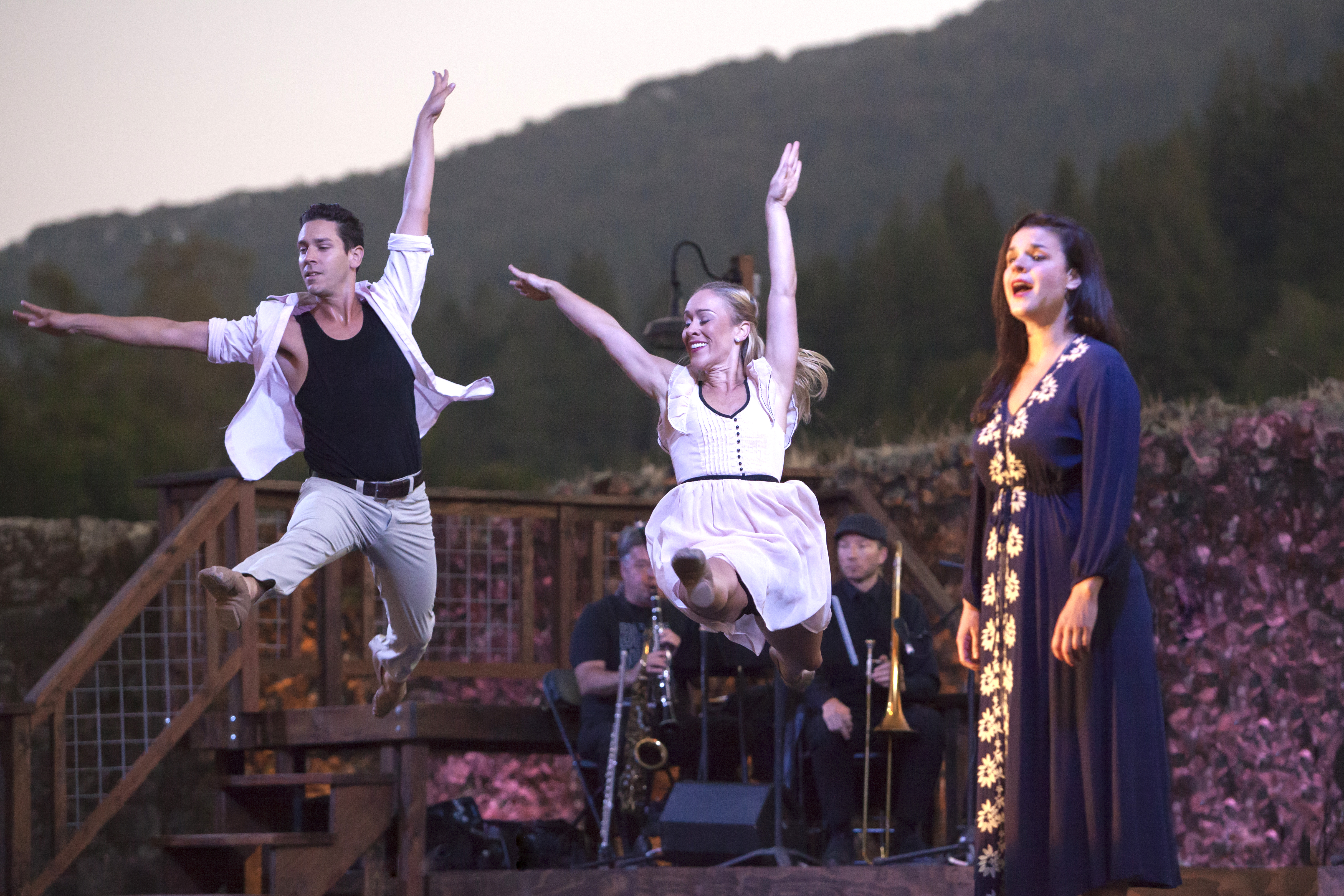
Pas de Don’t: From a previous year’s Transcendence production. (Photographer unknown.)
In the first act, the show is stopped for a game of “Family Feud” with a group of performers facing off against the family of one of the performers, emceed by Transcendence co-executive director Brad Surosky. Why? The survey questions they’re asked have nothing to do with Broadway or singing or performing or anything. (One of the family members, when asked “Name something that makes you feel better” answered “Jesus Christ.”)
The cast is mostly adequate (as one would expect), with Luis Figueroa and David R. Gordon acquitting themselves the best. But only one performer, Shaleah Adkisson, has true star quality. Naturally, she isn’t given enough to do, and what she is assigned is head-scratching. Before singing Christine Lavin’s very funny “Air Conditioner,” she acts out an expurgated excerpt from a viral YouTube video by Krissy Chula, “It’s Hot as Hell.” (Neither Chula nor Lavin is credited in the program, a rather appalling oversight.) Other than that, Adkisson has a solo line here or there in the ensemble numbers, but nothing really befitting her relaxed, unforced, confident, and abundant talent. (She virtually alone refrains from pushing in a cast full of pushers.) That she doesn’t have more to do points to another problem: The cast is too large. Gonzalez could get away with almost halving the number of performers and each would be better able to make an impression. As it is, most of the performers get one solo and a few ensemble numbers, and by the end of the show you struggle to remember most of them.
Technically, Matt Smart’s music direction is quite good, Nils Erickson’s sound design supports the orchestra and the singers ably, but the lighting design, by Jeffrey Porter, relies too much on a follow spot and can leave a number’s supporting cast members underlit when they’re clearly meant to be seen.
The audience, predictably, ate up such cornball antics as singing “O, Sonoma” for “Oklahoma” (even though no other lyric was changed, rendering the song nonsensical) and couldn’t wait to leap to their feet in a standing ovation at the evening’s end. (You’d think by now I’d be used to being the lone dissenter in an adoring throng, but alas.) Given the huge success Transcendence has had appealing to the lowest common denominator there’s not much hope things will improve in the future. Transcendence, despite its vast resources of both money and talent, squanders it all on insipidness, belying its very name.
Transcendence Theatre’s Stairway to Paradise continues through July 1. For more information, go to http://www.transcendencetheatre.org.
Stumbling: “Head Over Heels” Aims for Broadway

Gettin’ the beat: Taylor Iman Jones and ensemble (Photo: Joan Marcus)
The Go-Go’s were a significant portion of the soundtrack of my high school and college years. Their pop-punk songs managed to be both effervescent and gritty. Many of my peers dismissed them as pabulum, mainly due to their irresistible party song, “We Got the Beat.” (If a pop song is irresistible enough, there will be any number of teen-aged cranks who will proudly state their resistance. I know, I was one of those cranks, just not in this particular case.) But that didn’t stop my entire college dorm from borrowing my Beauty and the Beat album to make a cassette copy for their own use. And a song like “Our Lips Are Sealed” is both irresistible and smart. I’m an especial fan of their second album, Vacation, which Rolling Stone said was “the sound of women at work.” Amen.
If you’re going to make a jukebox musical using the Go-Go’s catalog, it needs to be a party. Love, romance, heartbreak, and jealousy can all be part of the mix, but at its base, the show needs to make you want to get up and dance. Head Over Heels, the new musical named after a song from the group’s 1984 album, Talk Show (their third), is such an odd combination of sources and styles, you wonder if it just might work. The story is adapted from Philip Sydney’s late 16th-century Elizabethan romance, The Countess of Pembroke’s Arcadia, the tale of Arcadian King Basilius (Jeremy Kushnier) who seeks to defy the dire prophecies of the Oracle at Delphi (the drag artist Peppermint), by taking his family—his wife the Queen (Rachel York), his two marriageable daughters—and his entire kingdom on the road. Conceived and originally written by Jeff Whitty (of Avenue Q fame) when it was presented at the Oregon Shakespeare Festival, James Magruder (who wrote the script for the musical version of Marivaux’ The Triumph of Love) has adapted it anew for this pre-Broadway incarnation. (The show moves to New York directly after its San Francisco run.) Rock music applied to stories from other centuries has worked before, most notably in Spring Awakening. Head Over Heels features the same director, Michael Mayer, who also captained American Idiot and Hedwig and the Angry Inch for Broadway, so he knows a little something about rock musicals. The cast is an attractive and talented mix of newcomers and veterans (including, thankfully, York, who knows her way around a musical). The show features a six-piece, all-female band, with orchestrations by Tom Kitt, and the choreography is by the talented Spencer Liff, best known for So You Think You Can Dance.
Does it work? Almost none of it. It’s actually rather shocking that almost no one involved with this production understands the appeal of the Go-Go’s and their music. The show is over-written, over-designed, over-choreographed, and over-sung, and both the music and the show sink under the weight of all that effort. Magruder keeps the iambic pentameter of the original for the dialog, and most of the actors don’t have a facility with the verse. This is especially true for Taylor Iman Jones as Mopsa, the servant who also serves as narrator. She gets the bulk of the rhyming couplets and appears to be the least able to deal with them. Mayer’s solution for his cast’s apparent inexperience is to have them recite the lines slowly, which only exacerbates the problem. Worse, Whitty and Magruder turn the show into a plea for (actually more of a sermon on) transgender acceptance. (Why are they pleading for it? Why don’t they just accept their transgender characters?) As the Oracle, Peppermint (a veteran of RuPaul’s Drag Race) seems slightly uncomfortable not performing her own material, and Andrew Durand, who actually acquits himself fairly well as the shepherd boy Musidorus, dons Amazon drag in order to be near the princess he loves, Philoclea (Alexandra Socha of the Amazon series Red Oaks, also fine.) Both of these characters explicitly plead for acceptance of their drag selves. But drag is not transgenderism (Peppermint’s bio identifies her as a transgender woman, demonstrating that there may be overlap), and no one goes to a musical for a sermon. (People see South Pacific in spite of the sermonizing.)
The show opens fairly well, with the ensemble performing “We Got the Beat” (of course), and the first few couplets contain enough jokes in them to make you hopeful. Julian Crouch’s set design, echoing the florid, meticulously painted drops and flats of earlier centuries, and costume designer Arianne Phillips rock-and-roll take on Elizabethan dress can be fun on their own terms at first, but as the show goes on, the relentless detail and décor feel overwhelming and heavy.
Liff’s choreography is, frankly, a disaster, fussy and over-conceived, with lots of vogue-ing and posing. The talented ensemble works and works (or “werks,” as the kids would say), but there’s never a feeling of joy or abandonment to the music. When I was young, a song by the Go-Go’s could get the entire room up and dancing. The cast has to beg the audience to stand up and join in at show’s end. Jerry Mitchell’s deceptively simple choreography for Hairspray matched the pop appeal of its score and made the audience want to be up there with the cast, having as much fun as they were. No such temptation arises in Head Over Heels.
The sound mix is also off so the vocals get lost under the music and have too much treble when they are audible. Perhaps the biggest problem is how the songs are performed. As in Mamma Mia!, the singers are encouraged to back phrase, in that fake-soul style so beloved by Broadway. Go-Go’s lead vocalist Belinda Carlisle had a straightforward, reedy vibrato that evoked the girl down the street, but could also soar when backed by her bandmates’ harmonies. Here, either Kitt or music director Kimberly Grigsby encourages everyone to ornament and wail, and even Socha adds a little coloratura to one number to make it more comic. The worst offenses are the duets between Taylor Iman Jones’ Mopsa and the eldest princess Pamela (Bonnie Milligan). The two try to out-belt and out-scream (or out-“screlt” as industry jargon would have it) each other, and it’s unbearable. The score uses two non-Go-Go’s songs more effectively, both of them post-group singles by Belinda Carlisle. “Mad About You” works because Durand sings it simply and sweetly, while “Heaven is a Place in Earth,” a song I loathe, is so bombastic it actually succeeds as camp, in line with all the other posturing (although the erotic shadow play it accompanies grows tiresome).
Thank god for consummate pro Rachel York, even though she really doesn’t have enough to do. There’s a tiresome recurring bit where when a character is struck by lust, the light’s change, the band plays a short sample of the song “Skidmarks on My Heart,” the actor thrashes around as if shocked, and then everything instantly returns to normal. (This is unfortunately the only use of “Skidmarks,” another great song.) For this to work, the sample needs to start and stop instantaneously, which is hard to do with a live orchestra, the thrashing needs to be precise, and everything needs to be timed perfectly. The bit works exactly once, when Rachel York does it. Her singing isn’t exempt from ornamentation, but she connects with the songs in a way that most of the rest of the cast doesn’t.
Even though I’d never get wealthy betting on the New York Times critics’ reactions, I can’t see this doing well on Broadway. It’s not another biographical catalog musical (hurrah), and it takes chances in its pairing of two disparate sources, but a show that evinces no understanding of the music it’s using as a score, and worse yet, isn’t any fun, is unlikely to pull in the crowds. Head Over Heels plods when it should float. The beat gets lost and never found.
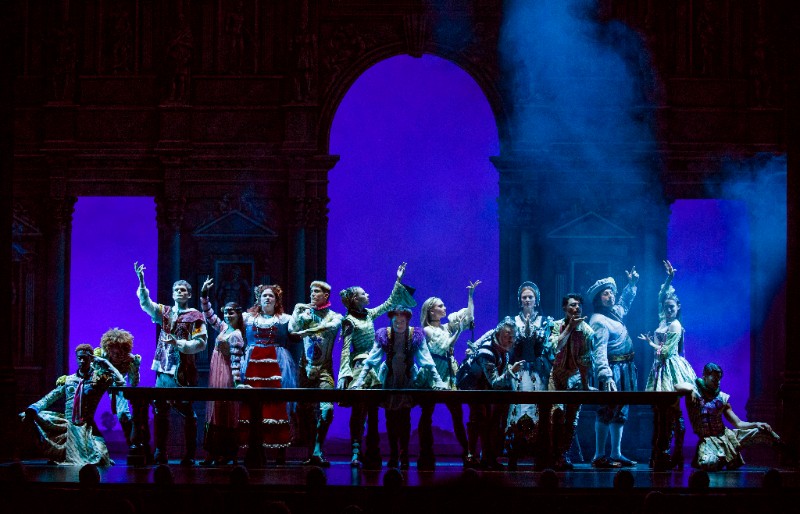
Skidmarks on My Heart: The Ensemble of Head Over Heels. (Photo: Joan Marcus)
Head Over Heels runs through May 6, 2018 at the Curran Theatre. For more information go to https://sfcurran.com/shows/head-over-heels/.
Call on Bernadette: Broadway’s “Hello, Dolly!”
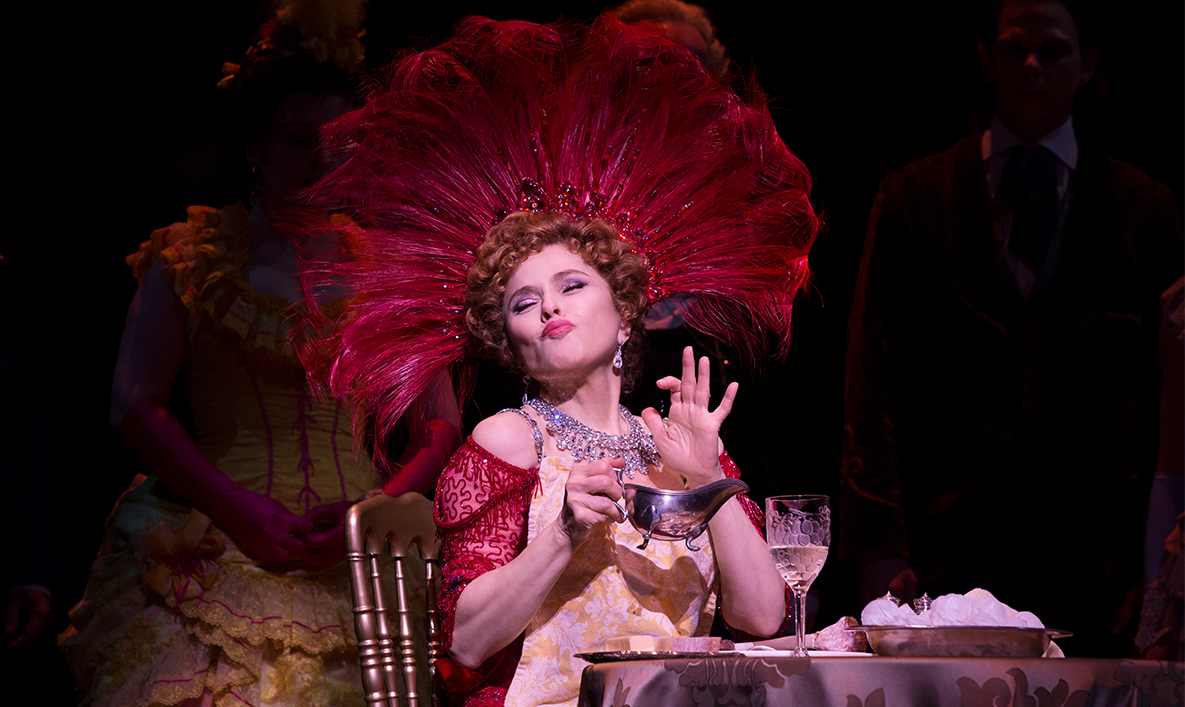
Not exactly perfection, but maybe something better: Bernadette Peters as Dolly Levi. (Photo: Julieta Cervantes)
I’ve never been a huge fan of Jerry Herman’s Hello, Dolly! despite its lofty reputation. To be fair I’ve seen only local productions, as well as the overstuffed movie version (which nevertheless features a great star turn by Barbra Streisand and an exhilarating cameo from Louis Armstrong). But it always came across to me as a rather brittle and artificial show about a pushy woman who browbeats a miserly grouch until he has an unconvincing reformation and agrees to marry her. And then there’s that endless dancing waiter scene at the Harmonia Gardens, an exercise in the mechanics of farce without any of the joy. But there’s no denying the show-stopping power of the title song, and several of the other numbers are lovely.
Jerry Zaks’ new Broadway revival is expertly mounted and lavishly produced, and it currently features Broadway legend Bernadette Peters in the title role, famously taking over from Bette Midler, whose star wattage guaranteed sell-out crowds. Peters is a very different performer from Midler, although they’ve both played Mama Rose and now Dolly Levi. Peters has also played Annie Oakley, and could probably be cast in several other Ethel Merman, brass-gong roles, but Peters has a delicacy and vulnerability that is never far beneath the surfaces of her star turns. I’m sure that when Bette Midler made her entrance as Dolly, she owned the stage instantly and never let it out of her grip. Peters, in what in many ways is a revelatory interpretation, portrays Dolly as an actual person, as a lonely widow who is trying very hard to make it in this world by the force of her own will, but is also exhausted from having to do so. She doesn’t hold the stage in the way Midler must have, but by the time of the Act I finale, “Before the Parade Passes By,” she owns the hearts of everyone in the theater. She imbues the song with emotion, with both sorrow and hope, loneliness and joy, that has never been associated with any previous version of Dolly that I’ve seen.
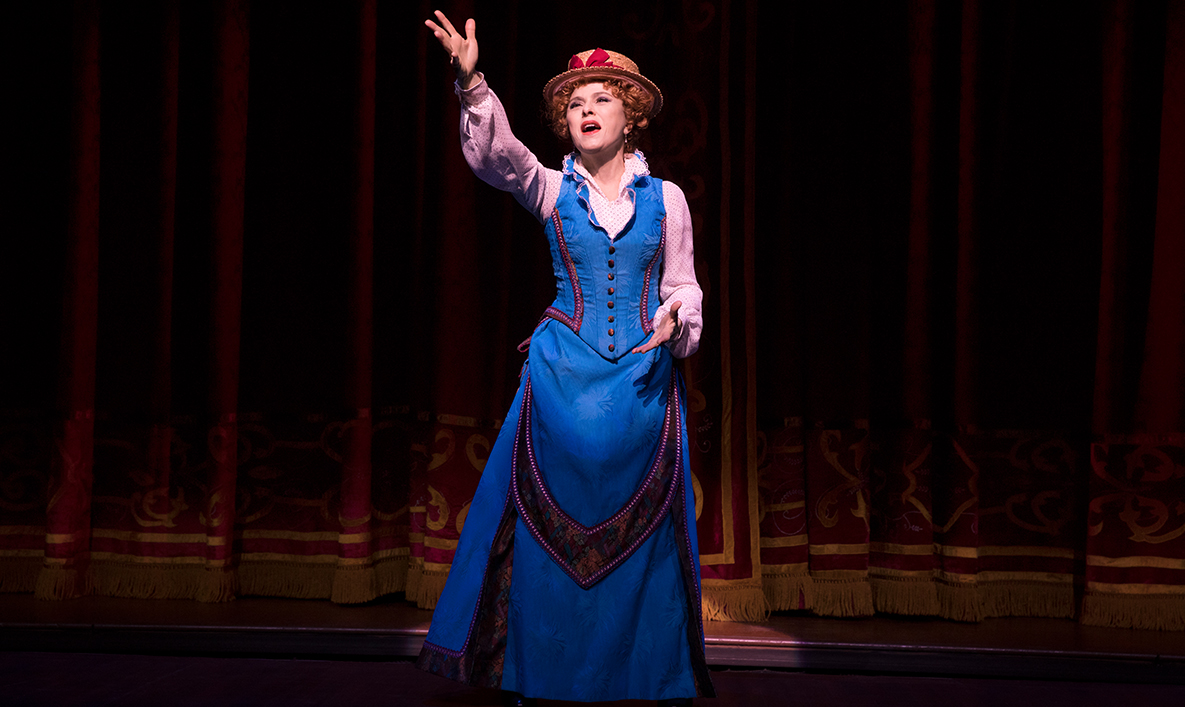
(Photo: Julieta Cervantes)
The first act is pretty much bliss, despite its lackluster opening number, “I Put My Hand In.” (Streisand knew what she was doing when she asked for a different song for the movie.) It certainly helps that Peters is supported by a dream cast. Victor Garber as blowhard Horace Vandergelder somehow gives the old coot warmth and charm even as he’s forbidding his daughter from marrying the gangly artist she’s in love with, and denying his employees any time off ever. It finally makes sense that Dolly sees something in Horace that no one else around him would ever fathom he possesses. And Santino Fontana (newly replacing Gavin Creel) is wonderful as head clerk Cornelius Hackl. Fontana expertly calibrates his performance to the artificiality of the show, bringing a reality and a groundedness, along with true charisma. As his sidekick Barnaby, Charlie Stemp mugged a bit too much at first, but eventually won me over with his terrific dancing and comic physicality. The wonderful “Put on Your Sunday Clothes” is a triumph, and when Zaks and his choreographer Warren Carlyle bring on a huge train that there couldn’t have possibly been wing space for, the number soars to the moon.
Things only improve when Kate Baldwin appears as Horace’s putative match, Irene Molloy. Baldwin gives the role a slightly bawdy zestfulness, as well as turning the usually wan “Ribbons Down My Back,” into something rather beautiful. And her scenes opposite Fontana are terrific. As her underling Minnie Fay, Molly Griggs is great fun, being both scandalized and delighted by Irene’s behavior, and matching up beautifully with Stemp’s Barnaby.

Kate Baldwin as Irene Molloy. (The wonderful costumes are by Santo Loquasto. Photo: Julieta Cervantes.)
The second act is a bit rockier. Garber performs the opener “Penny in My Pocket” (cut from the original production) like the old pro he is, and it’s wonderful. But even Zaks and Carlyle can’t overcome the endless “The Waiters’ Gallop,” where the chorus boys spend way too much time dodging scenery and juggling props. Peters also has problems in the two big scenes where she has to dish up and chow down on enormous quantities of food. She broke character in both sequences the night I saw her, laughing as potatoes and beets strayed from the plates supposed to contain them. (The audience forgave her, but even so. I’ve heard Midler excelled in these scenes, which is no surprise given her talent for physical comedy, which is not one of Peters’ strengths.) But when the title song kicks in, with its expert construction and brilliant staging, showing off Peters brilliantly, the overwhelming showbiz razzmatazz of it all sends you into a giddy delirium. It’s heaven.
When all is set right by play’s end, the show, at its best, comes off like a crazy Midsummer Night’s Dream, with mismatched lovers set aright by a lovely, even slightly heartbreaking sprite named Dolly. Peters, Zaks, and the wonderful cast haven’t completely changed my opinions of the material, but they gave me far more pleasure than I thought a production of Hello, Dolly! ever could.

Victor Garber and Bernadette Peters. (Photo: Julieta Cervantes)
Hello, Dolly! continues indefinitely at Broadway’s Shubert Theatre, New York. For more information, go to http://hellodollyonbroadway.com/.
Paradise Found: “An American in Paris”
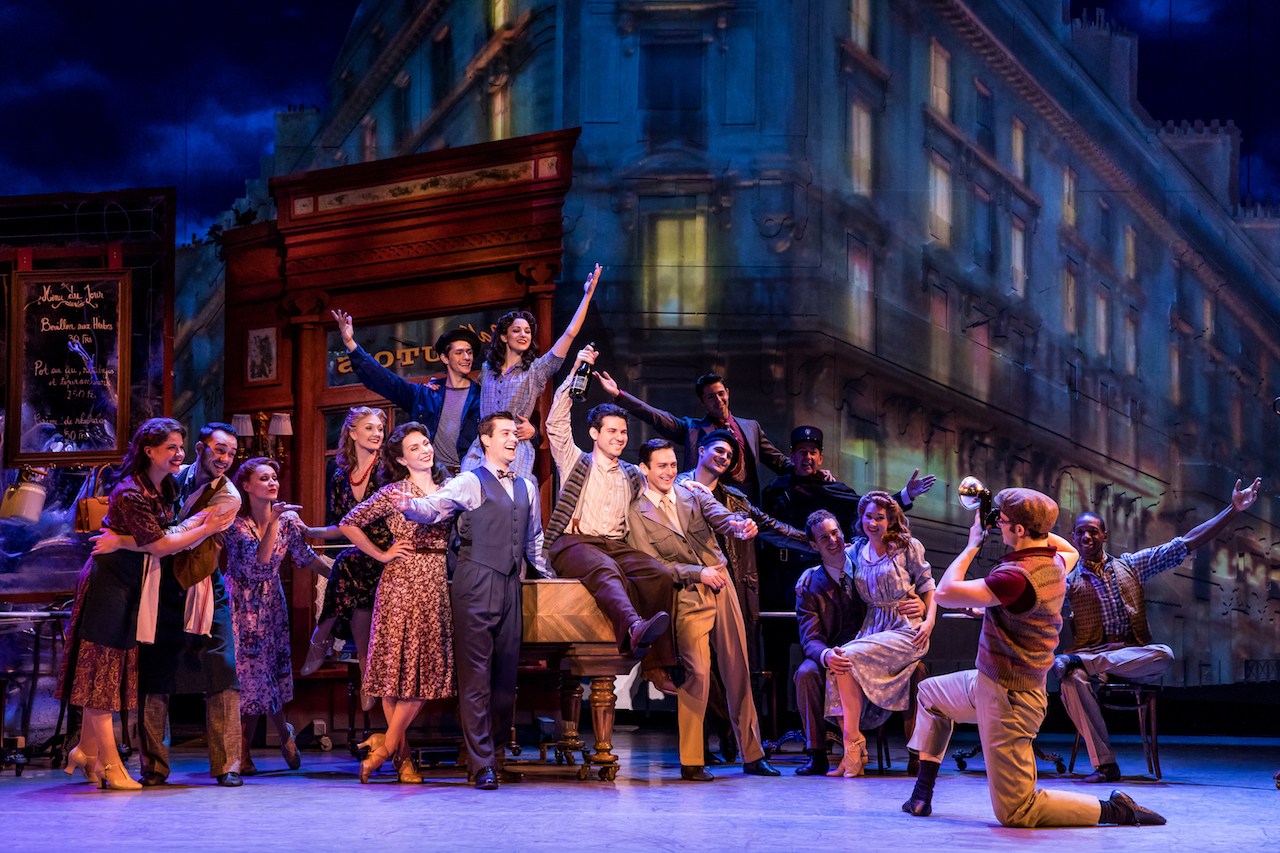
The company of An American in Paris. (Photo: Matthew Murphy)
Christopher Wheeldon (director and choreographer) and Craig Lucas’ (book) adaptation of the classic movie musical An American in Paris begins with a single piano on stage backed by a drop that’s almost completely black, but you can make out the famous lines of the Arc de Triomphe. Gershwin’s “Concerto in F” begins, and the company of dancers, dressed in greys and blacks, enacts a sequence of lingering grief, continuing conflict, reunited lovers, and joyous homecomings. It’s 1945 and the City of Lights is coming back to life after years of darkness. Large abstract set pieces glide on and become part of the choreography, and with exquisite projection design (credited to “59 Productions”), the dancers move, leap, and soar through the damaged city.
The number establishes the show’s independence from the famous movie, set in 1951 and opening with sunny shots of the familiar sites of Paris. (The “Concerto” is also in the film, but used humorously and not as an opening number.)
We then find ourselves in a café, where an American ex-GI Adam Hochberg (Stephen Brower), a pianist and composer, is beginning rehearsal with Henri Baurel (Nick Spangler), who harbors secret dreams of starring in cabaret despite being the scion of a wealthy Parisian family who has different expectations for him. They are joined by Jerry (Ryan Steele), another ex-pat GI who’s stayed around in Paris to be an artist, and the three begin joking around to the strains of “I Got Rhythm,” other patrons joining in as the bar becomes more crowded. The lights go out, but the resourceful crowd starts the music back up. No one can stay down for long during “I Got Rhythm.”
The next day, Adam is playing for a ballet company’s auditions, Jerry shows up with some of his sketches, and a young dancer Lise (Sara Esty) arrives late, but inserts herself into the audition at Adam’s urging. Both Adam and Jerry (who has encountered her briefly previously) are smitten. A wealthy American woman, Milo Davenport (Emily Ferranti) is taken with all three of them, and wants the company to produce a ballet using Adam’s music, Jerry’s designs, and starring Lise. Milo is especially attracted to Jerry, while Henri turns out to have a mysterious entanglement with Lise. With five possible young lovers, the math cannot work out, and we know that there will be heartbreak and sacrifice to come. But these are people who are familiar with both.
These opening scenes are miraculous. Wheeldon the director keeps almost everything in motion, even during the dialogue, and the set pieces are brought on and off the stage by the ensemble, who whirl and partner with the scenery. Every second, every detail is choreographed and planned, but it all unfolds with such ease and fluidity that it takes your breath away.
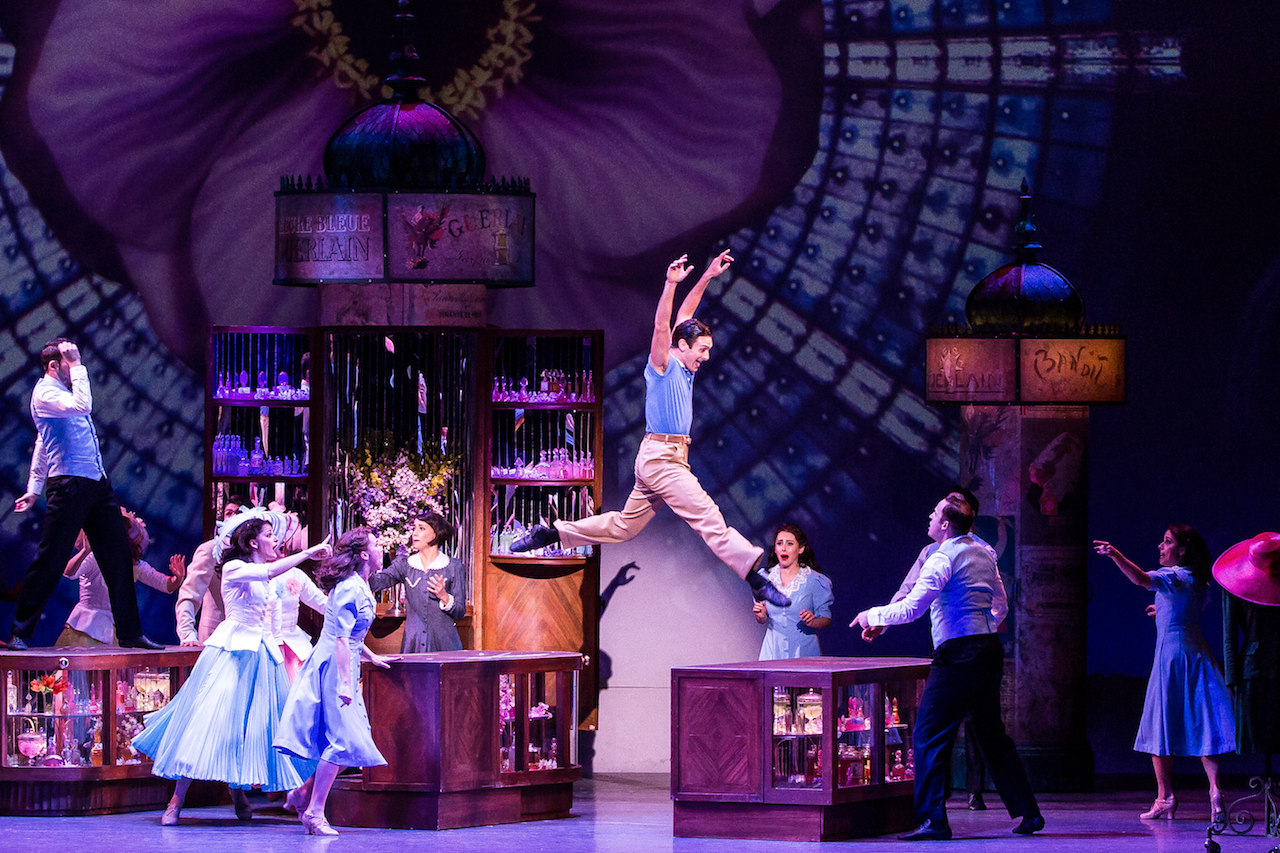
Jerry (Garen Scribner, no longer with the tour, is pictured here) causes a stir at Lise’s (Sarah Esty) place of work. (The role of Jerry now alternates between Ryan Steele and McGee Maddox. Esty alternates in the role of Lise with her sister, Leigh-Ann Esty.) (Photo: Matthew Murphy)
An American in Paris is a production with flaws, quite a few actually, most in the second act, and most as a result of Lucas’ book. Lucas’ writing can be over-explicit and in his attempt to deepen the material, he darkens it in a way the show can’t support. The major problem is the connection between Lise and the Baurels (Henri’s family), with whom she lives. The revelations of their war-time activities are over-complicated and come across as melodramatic—too fraught for the show and its music. Lesser problems include jokes about Henri’s sexuality that seem anachronistic and don’t go anywhere (the suggestion that he’s gay actually lessens the richness of his character), the interpolation of “Fidgety Feet” (from the Gershwin’s Oh, Kay) seems shoe-horned in and doesn’t match the tone of its surrounding scene (although the choreography is wonderful), and the leads’ singing ranges from the adequate to the good, never really approaching the spectacular. (However, they all display an immense respect for the music—there is no obnoxious ornamentation, no modern pop stylings. The music is sung as written, and the singers trust it will convey what is needed.) I think the creators also make a mistake with “I’ll Build a Stairway to Paradise.” This is used as Henri’s nightclub debut, and he starts out nervous and off-key, but then it becomes a fantasy sequence with the ensemble in feathered headdresses and top hats tapping in front of stylized (and gorgeous) representations of the Chrysler building. But the way the number is set-up, we’re supposed to see Henri come into his own as a performer during the number. Because fantasy overtakes the production, we don’t see Henri learning to relate to his onstage audience, overcoming his jitters, and triumphing, which is clearly what the scene is supposed to be about.
Even though these missteps aren’t negligible, I have to admit that ultimately, I don’t really care about them. An American in Paris is bliss. You can’t believe Wheeldon, a former ballet dancer and internationally renowned ballet choreographer, hasn’t directed a musical before. His staging is masterful, his dance creations entrancing, and even the show’s scene changes are gorgeous. (Pieces are brought on and off by the ensemble with grace and fluidity.)
Despite the problems in the script, Lucas’s reconception of the film is bold and imaginative, and it does deepen the source material. There hasn’t been a musical in which dance is so primary in a long time (Hairspray being the last one I’ve seen, although I’ve heard it’s a central part of Bandstand and a few others), and you’d have to go back to the middle of last century to find a show where ballet is the primary dance form. Wheeldon defines his characters and settings through ballet, and the work of he and his cast is stunning. The characters become their best, most luminous selves when they dance, even as they retain their flawed humanity.
I adore the movie, but its most famous sequence, the “An American in Paris” ballet set to Gershwin’s 1928 composition, is also its biggest mistake. Gene Kelly and Leslie Caron cavort through a series of sets based on Impressionist and Post-Impressionist painters, but the 18-minute sequence has nothing to do with the rest of the movie. It isn’t Jerry and Lise performing, it’s Gene Kelly and Leslie Caron. Nothing is revealed, nothing is at stake, and the final effect is one of pretension.
In the musical, the ballet is the result of Milo’s commission, set to Adam’s composition, with Jerry’s color-block designs, and Lise as the prima ballerina. Lucas provides a context for the number, Wheeldon brings all his choreographic and story-telling experience to the piece, and it’s extraordinary. The middle section is a fantasy pas de deux between Jerry and Lise, and with only Gershwin’s timeless music and Wheeldon’s gorgeous movement, we watch as Lise clarifies her feelings about love and about Jerry. She’s changed by the end of the piece, and so are we.
Sara Esty is marvelous as Lise, bringing color and shade to her character and grace and lightness to her movement. Steele is an extraordinary dancer who floats and soars, unimpeded by gravity. The play’s soul resides in Brower’s Adam, who subsumes his love and his sorrow into his music. And Emily Ferranti is terrific as a patron who knows that as essential her money may be to the creation of art, she will always be at a remove from these artists and their work. She can appreciate but she can’t participate. (Another interpolation, “But Not for Me,” from Girl Crazy, that Adam and Milo sing together, is inspired. It doesn’t hurt that this may be the best song the Gershwins ever wrote: “They’re writing songs of love, but not for me./ A lucky star’s above, but not for me.”)
Underneath all of this is the wonderful music of George Gershwin (and Ira’s lyrics), and any review that doesn’t extol the work of Rob Fisher, the founding music director of New York’s Encores! Series, in adapting and arranging this marvelous score (expertly performed by a thirteen-member orchestra) would be seriously remiss.
An American in Paris, in all its imperfections, still does everything a musical should do. You leave the theater floating, astonished and grateful. Wheeldon, Lucas, and Fisher have created their own stairway to Paradise.
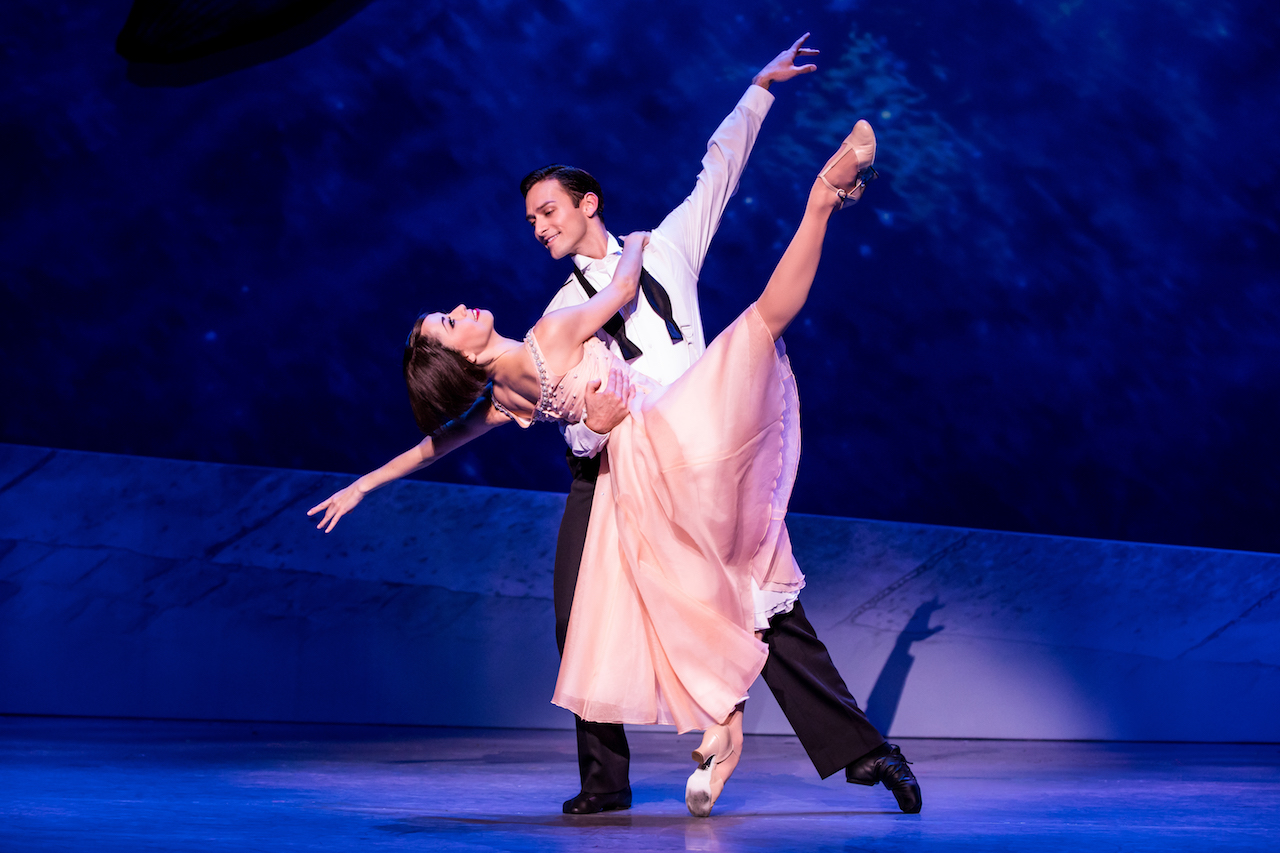 An American in Paris plays through October 8 at the Orpheum Theatre, 1192 Market Street, San Francisco. For more information, go to https://www.shnsf.com.
An American in Paris plays through October 8 at the Orpheum Theatre, 1192 Market Street, San Francisco. For more information, go to https://www.shnsf.com.
Resisting Temptation: Berkeley Rep’s “Ain’t Too Proud”
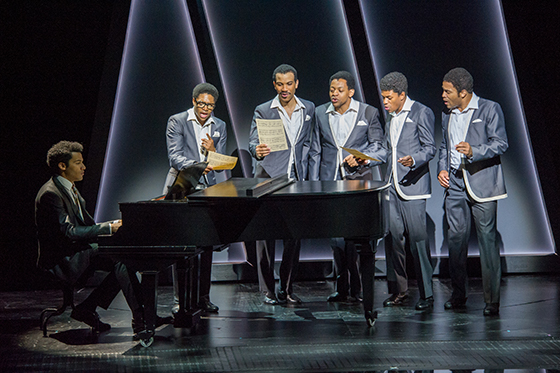
Christian Thompson (Smokey Robinson), Ephraim Sykes (David Ruffin), Jared Joseph (Melvin Franklin), Derrick Baskin (Otis Williams), Jeremy Pope (Eddie Kendricks), and James Harkness (Paul Williams) in “Ain’t Too Proud—The Life and Times of The Temptations.” (Photo: Carole Litwin)
Berkeley Rep’s new Broadway try-out, Ain’t Too Proud—The Life and Times of The Temptations, is another jukebox musical biography (or as playwright Dominique Morisseau refers to it, a “catalog musical”) in the vein of Jersey Boys and Beautiful: The Carole King Musical, but focusing this time on the phenomenally successful Motown artists. (The production also shares a lineage with Motown: The Musical, Berry Gordy’s execrable paean to Berry Gordy. When you watch Motown, one of the things you think, aside from how much it stinks, is that any one of these groups deserves a show all of their own. Thither Ain’t Too Proud.) I had high hopes going in, because I adore The Temptations (who doesn’t?), their music is wedded to their choreography in a way that seems particularly stage-worthy, and their songs are emblematic of an era in American history in a way that the other two aren’t, no matter how much I may love their work.
The show is essentially sold-out, even after being extended, and it will almost certainly be a huge hit on Broadway. You can understand why when you hear those amazing hits performed by the five ferociously talented young actors and dancers who play the original members of the group. (The ensemble, playing roles such as Diana Ross and the Supremes, Smokey Robinson, Berry Gordy, replacement members of the group, and wives and lovers, is also exceptional.) With any justice, two of them, Jeremy Pope as Eddie Kendricks and Ephraim Sykes as David Ruffin, will become big stars. (Sykes played the role of Seaweed Stubbs on the recently televised Hairspray Live!, one of the few bright spots in that misbegotten venture.) Oozing charisma, Pope, with his gorgeous falsetto, and Sykes with his growling baritone hold the stage in every scene, projecting an effortless joy with their singing and dancing.
But for me the show is a major disappointment, with the fault for that lying directly in Morisseau’s book and director Des McAnuff’s conception. This is Morisseau’s first musical, having previously written such plays as Pipeline, Detroit ’67, and Skeleton Crew. Old hand McAnuff directed Jersey Boys, just one of a storied slew of his Broadway successes.
Morisseau’s based her book on The Temptations, written by Otis Williams, the last surviving member of the original group. Her solution to dramatizing his story is to tell it from his point of view, Williams being embodied by actor Derrick Baskin. Baskin is thus on stage for the entirety of the running time, mostly addressing the audience directly, interrupting songs and scenes to tell us information we already know. You’ll be shocked to learn that offstage, the Temptations had problems with drugs, were involved in marriage and relationship difficulties, endured racism, and fought a lot with each other. And that’s essentially all we learn about these artists.
Similar to Jersey Boys and Beautiful, Ain’t Too Proud presents the biographical details of its protagonists’ lives as generic soap opera. Morisseau and McAnuff are incapable of presenting the Temps as people, so it’s no surprise the cast ultimately comes through only as performers. The creators also split up and interrupt the songs, so that Baskin/Williams can explain and narrate, or unimaginative bits of dialogue or scenes of discord can take place. We almost never get to hear an entire song, despite these being some of the greatest tunes ever to come over the radio.
The creators also use certain numbers as book songs, as McAnuff did in Jersey Boys, a cheap theatricalization that drives me crazy. In a typical romantic musical, we go along with the illusion that when a character breaks into song, he or she is making it up on the spot, singing spontaneously in reaction to the circumstances. But in a musical biography, the show is supposed to be about the creation of that music, about the work, the rehearsal, everything that goes into making a hit recording or performance. So when a character breaks into one of the group’s hits to express their love for their girl or their anger at each other or their sadness at leaving the group, the show becomes as phony as it gets.
Robert Brill’s overly austere set tends towards greys and blacks as do Peter Negrini’s, projections (which are really what are relied on to set the scene). We get no brightness or color until the Supremes make an appearance in red sequined dresses, then it’s back to the greys with an occasional subtle blue. Negrini also anachronistically uses the modern, gleaming metallic Motown logo, a stylized ‘M.” That red, green, and yellow logo that adorns so many of my treasured records and 45s is nowhere to be found. Luckily, veteran Sergio Trujillo’s choreography is terrific and looks great on the cast. (Trujillo also created the movement for Jersey Boys, the Gloria Estefan “catalog musical” On Your Feet—a show I will never see—and a number of other prominent productions.)
Why can’t Broadway figure out how to personalize these artists when their stories are brought to the stage? (The much-reviled yet hugely successful late ‘70s smash Beatlemania at least had the good sense not to have any book at all.) The answer is pretty simple: Because they don’t have to. These shows have a built-in audience, tourists and theatregoers lap up tickets to hear songs they already know. The productions get Tonys and other awards even when the critics are lukewarm, and they run for years, spawning tour after tour. Why should the writers and directors work to create art, when the audiences are already responding to the music and aren’t asking for anything more? Well, despite the success of these shows, despite the royalties that pour in to the surviving artists, and the pots of money the producers make, theatre-goers get no real understanding of these artists as people, what it costs, emotionally, financially, and physically, to make an audience experience the joys of their art and performance. The books of these shows are about as interesting as Wikipedia entries, and the whole undertaking ends up undermining the artists and the very art they’ve created. But not even the Temptations are immune from temptation. This isn’t the first of these “catalog musicals” and it certainly won’t be the last. But I doubt I’ll be able to drag myself to another one, no matter how much I love the artist. They’re just too dispiriting.
Ain’t Too Proud—The Life and Times of the Temptations plays through November 5, 2017 at the Berkeley Repertory Theatre. For more information, go to https://www.berkeleyrep.org/season/1718/12025.asp.